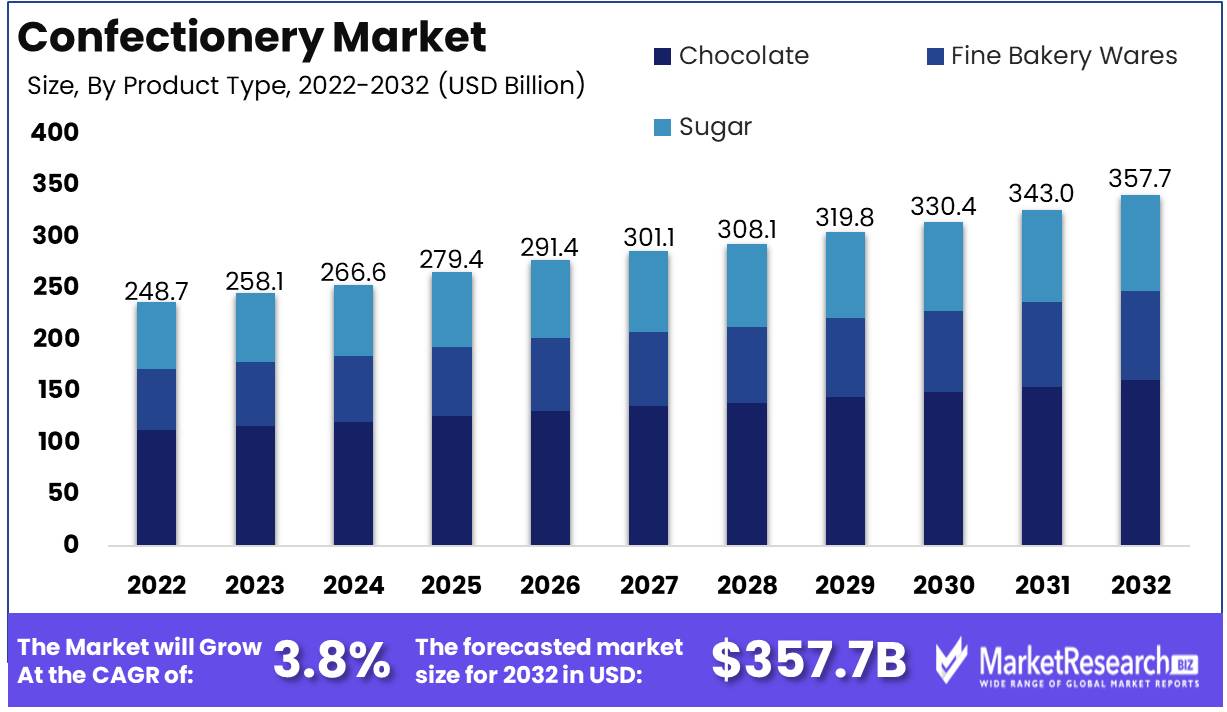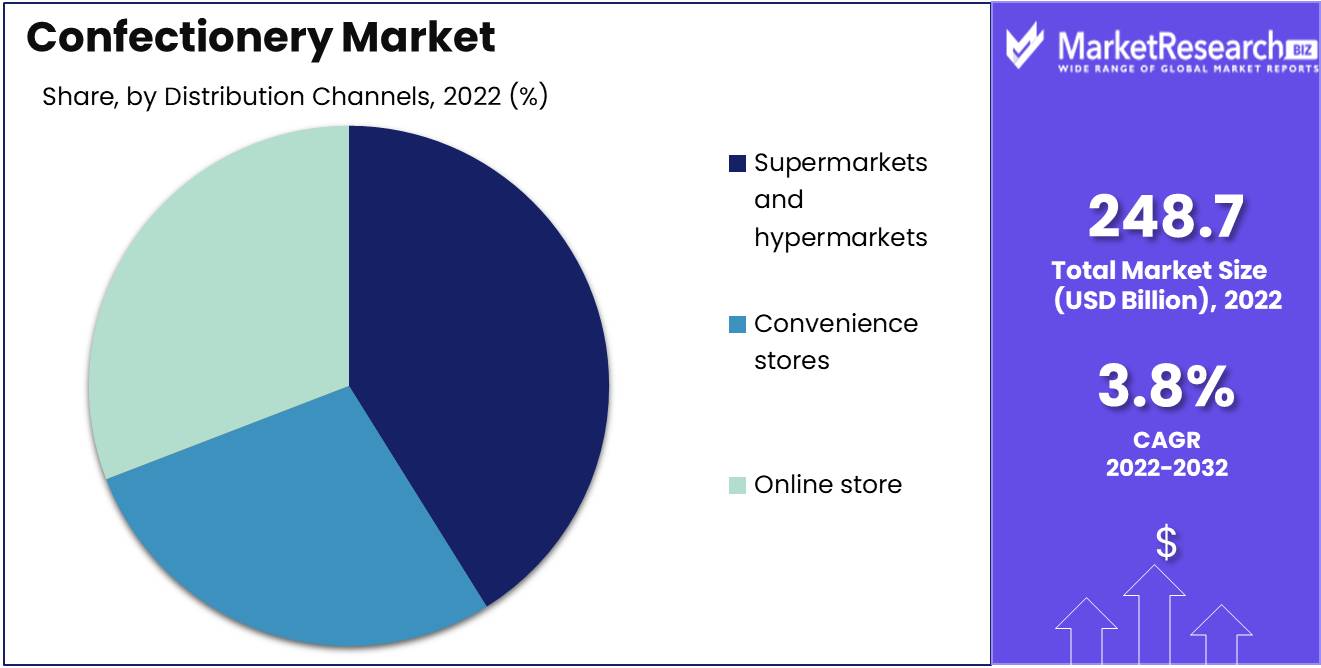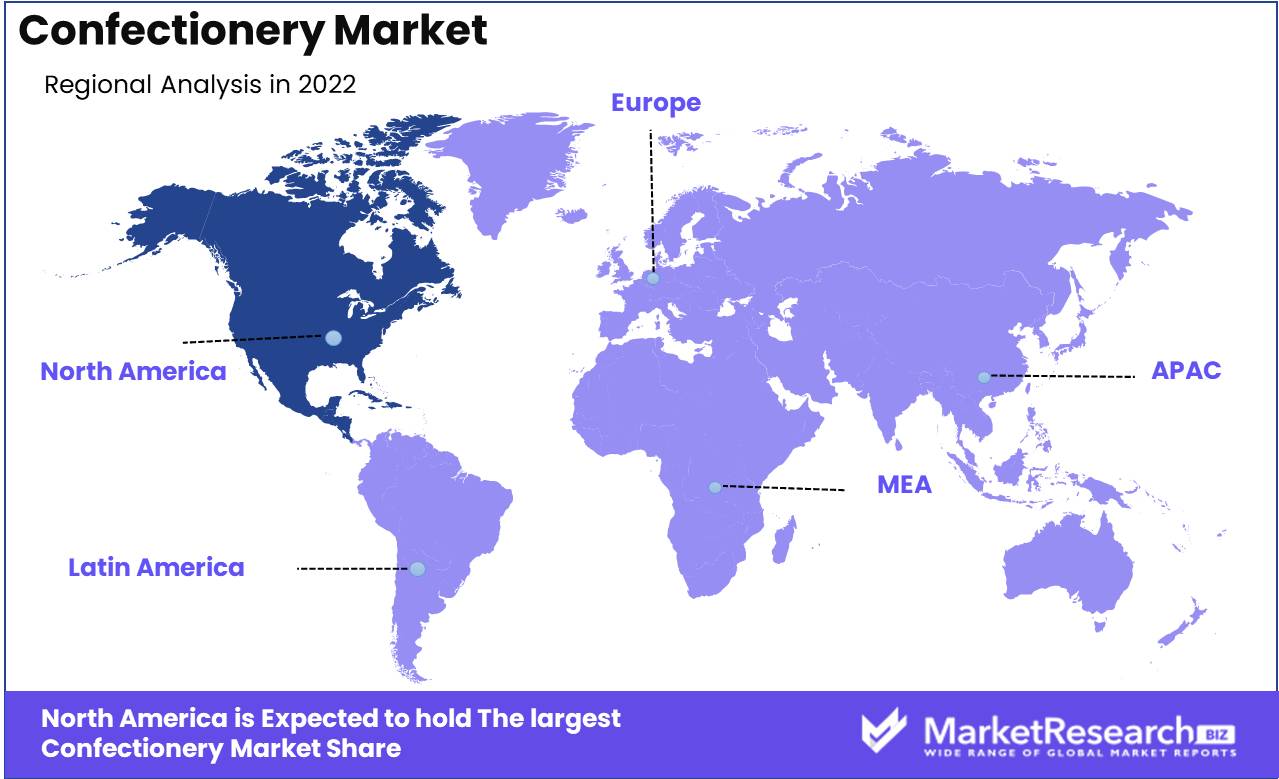
Confectionery Market Product Type(Chocolate, Fine Bakery Wares, Sugar), Distribution Channels (Supermarkets and hypermarkets, Convenience stores, Online store), By Region And Companies - Industry Segment Outlook, Market Assessment, Competition Scenario, Trends, And Forecast 2023-2032
-
5636
-
May 2023
-
150
-
-
This report was compiled by Shreyas Rokade Shreyas Rokade is a seasoned Research Analyst with CMFE, bringing extensive expertise in market research and consulting, with a strong background in Chemical Engineering. Correspondence Team Lead-CMFE Linkedin | Detailed Market research Methodology Our methodology involves a mix of primary research, including interviews with leading mental health experts, and secondary research from reputable medical journals and databases. View Detailed Methodology Page
-
Quick Navigation
Report Overview
Confectionery Market size is expected to be worth around USD 357.7 Bn by 2032 from USD 248.7 Bn in 2022, growing at a CAGR of 3.8% during the forecast period from 2023 to 2032.
The confectionery industry, which includes manufacturers, distributors, and retailers of various sweet treats such as candy, chocolate, gum, and mints, is growing due to a number of factors. These include the rise in disposable income, the ever-changing preferences of consumers, and the introduction of novel products with innovative flavors and alluring packaging.

The confectionery market, an integral component of the vast food and beverage industry, offers a vast selection of products for consumers of all ages. Candy, chocolate, and gum are commonly regarded as scrumptious indulgences that bring immense pleasure and happiness into people's lives. Their scrumptious and enticing flavor is the primary reason for their worldwide fame.
The primary objective of the confectionery market is to provide consumers with premium, delectable delights that can be enjoyed at their discretion. This necessitates an unwavering commitment to churning out fresh and innovative products that correlate with consumers' ever-changing preferences and tastes. In addition, businesses in this industry endeavor ceaselessly to provide a vast selection of products that cater to various dietary restrictions and lifestyle preferences.
Driving Factors
Increasing Population
Because of the growing world population, the confectionery market is expanding at an exponential rate. As the population continues to grow, so too does the demand for confectionery products. More people means a larger consumer base, resulting in higher sales and market expansion. The expanding population, particularly in urban areas, provides confectionery manufacturers with a substantial client base to target.
Urbanization
With more people relocating to cities and urban areas, urbanization directly affects the confectionery market. With a greater prevalence of potential consumers in a smaller geographical area, urbanization causes changes in lifestyle and consumer preferences. The convenience and accessibility of urban areas make it simpler for consumers to obtain confectionery products, thereby increasing demand. In addition, consumers in urban areas typically have a higher disposable income, allowing them to indulge in confectionery products more frequently.
Growing Disposable Income
Globally rising levels of disposable income have played a crucial role in propelling the confectionery market. As people's financial circumstances improve, they are able to spend more on non-essential items such as confectionery. Increased discretionary income permits consumers to occasionally indulge in chocolates, confectionery, and other confections. This increased purchasing power drives the demand for confectionery products and encourages manufacturers to introduce new and innovative products to meet consumers' changing tastes.
Changing Lifestyle Preferences
Changes in lifestyle preferences have also contributed to the expansion of the market for confectionery. In order to satiate their cravings and experiment with various flavors and textures, consumers increasingly seek out novel and distinctive product varieties. They are searching for confectionery products that correspond to their dietary preferences, such as organic, natural, or gluten-free options. Manufacturers have responded to these shifting preferences by introducing a vast array of confectionery items that appeal to various dietary requirements and lifestyle preferences. This constant innovation and product diversification contributes to the expansion of the confectionery market by appealing to a larger consumer base.
Restraining Factors
Health Concerns Regarding the High Sugar and Fat Content in Confectionery Products
Health concerns, including the high sugar and fat content of many confectionery products, are one of the primary reasons consumers are transitioning away from these items. Today's consumers are highly concerned with their health and well-being, and the demand for healthy refreshment alternatives is soaring. To combat this problem, numerous confectionery companies are introducing low-sugar, low-fat, nutrient-rich options that pander to this new health-conscious consumer.
The availability of healthy snack alternatives
While the confectionery industry struggles to adapt to shifting consumer preferences, the healthy refreshment industry has been thriving. With increasing awareness of the health advantages of wholesome and nutrient-dense refreshment options, a growing number of consumers now choose healthier alternatives over traditional confectionery items. Confectionery manufacturers are also entering the healthy snack market to combat this trend by launching their own lines of nutritious treats to meet consumer demand.
Profit margins are impacted by fluctuating raw material costs.
The fluctuating prices of basic materials are one of the most significant obstacles encountered by the confectionery industry. As a consequence, profit margins are under constant pressure, which can impact product quality. Due to these market pressures, it is essential for companies to keep a close watch on raw material prices and implement the necessary strategies to maintain their margins while delivering confectionery products of the highest quality.
Stringent government regulations and taxation policies
The confectionery industry is heavily influenced by government regulations and taxation policies. Excessive regulations and taxes make it difficult for businesses to operate efficiently and can have a negative effect on their profitability. Therefore, in order to avoid any legal or financial repercussions, it is essential for companies to remain apprised of any new policies that emerge and ensure compliance.
Product Type Analysis
Chocolate Segment Dominates Confectionery Market. From a primary component in confectionery, desserts, and bakery goods to a basic material for the production of ice creams, beverages, and candies. The chocolate segment has been a formidable force in the confectionery industry. The expansion of the chocolate segment of the confectionery market can be attributed to the rising demand for premium chocolates, which appeal to consumers seeking higher-quality products.
Emerging societies around the world are experiencing unprecedented economic expansion, which is driving the demand for chocolate products. Rising prosperity has increased the purchasing power of individuals, allowing them to indulge in premium chocolate products. This trend is especially evident in the Asia-Pacific region, where the middle-class population has increased, thereby driving up demand for premium products such as chocolate.
Today's consumers are increasingly concerned about their health and well-being, which has resulted in an increase in demand for chocolate products that are healthier and more natural. Chocolates with functional benefits such as enhancing cardiac health, facilitating weight management, and boosting the immune system are appealing to consumers. In recent years, the trend of giving chocolates as gifts to loved ones on special occasions has grown in prominence, contributing to the expansion of the chocolate segment of the confectionery market.
Distribution Channel Analysis
The convenience of purchasing goods from supermarkets and hypermarkets has dominated the Confectionery Market, leading to a growing preference for the channel over traditional markets. Due to their capacity to offer a wide variety of products under one roof, supermarkets and hypermarkets have become dominant distribution channels in the confectionery market, including popular chocolate products.
The economic growth of emergent nations has also contributed to the expansion of supermarkets and hypermarkets in the market for confectionery. As individuals increase in wealth, they desire convenience and premium products that are readily available in supermarkets and hypermarkets.
Due to the convenience afforded by supermarkets and hypermarkets, consumers prefer purchasing through these channels. In addition, the ability of supermarkets and hypermarkets to purchase products in volume at discounted prices is also contributing to their expansion in the confectionery market. Consumers' high level of impulsivity, complexity, originality, and human-like behavior toward supermarkets/hypermarkets is anticipated to continue propelling the expansion of this market segment.

Key Market Segments
By product type:
- Chocolate
- Dark
- Milk
- White
- Fine Bakery Wares
- Sugar
- Caramel and Toffee
- Jelly and Gum
- Mint
- Hard-Boiled Sweets
By distribution channels:
- Supermarkets and hypermarkets
- Convenience stores
- Online store
Growth Opportunity
Introduction of New and Exotic Flavors and Product Innovations
The introduction of novel and exotic flavors has revolutionized the confectionery industry. Manufacturers are currently experimenting with exotic flavors and ingredients such as ginger, matcha, and exotic fruits in order to appeal to the evolving tastes of consumers. This trend has also spawned product innovations such as nut-based confectionery and non-dairy chocolate that accommodate to consumers with specific dietary needs.
Growing Demand for Sugar-Free and Low-Calorie Treats
As the number of health-conscious consumers rises, so has the demand for sugar-free and low-calorie confectionery. In response, manufacturers have developed products that appeal to this expanding trend. Some manufacturers, for instance, have begun manufacturing sugar-free and low-calorie versions of popular candy bars and other confectionery items. This trend toward healthful products has also resulted in an increase in the popularity of nut-based treats and confectionery made with natural sweeteners.
Increasing Adoption of E-commerce and Online Retail Channels
The pandemic has accelerated the transition to online retail channels and e-commerce, which includes the confectionery market. Favorite confectionery items are progressively purchased via online channels. This has resulted in the development of new online retailers and the incorporation of e-commerce platforms by established manufacturers. In addition, e-commerce provides consumers with the convenience of ordering their preferred confectionery items from the comfort of their own residences and receiving door-to-door delivery.
The Growing Preference for Organic and Natural Confectionery Products
Consumers are progressively making informed decisions regarding the products they purchase, including confectionery. There is a growing preference for organic and natural confectionery produced with ingredients that are not only beneficial to health but also have a low environmental impact. Manufacturers have responded to this trend by creating products such as organic chocolate bars and all-natural gummy bears made with real fruit liquid.
Expanding Product Portfolio to Cater to a Diverse Customer Base
Now, confectionery manufacturers are diversifying their product offerings to appeal to a wide range of customers. This diversification is a result of consumer demand for non-traditional confectionery options. To accommodate consumer preferences, manufacturers may offer gluten-free, vegan, and kosher-certified products. In addition, manufacturers are now diversifying their product lines to accommodate various occasions, including holidays, nuptials, and other celebrations.
Latest Trends
Vegan and gluten-free confectionery is becoming more and more popular.
Demand for vegan and gluten-free confectionery products has increased significantly over the past few years. This trend can be ascribed to consumers' growing awareness of health and environmental issues. As more individuals adopt plant-based diets, demand for vegan confectionery has skyrocketed. Additionally, consumers with gluten allergies or intolerances prefer gluten-free confectionery.
To meet this growing demand, a number of confectionery manufacturers have begun offering vegan and gluten-free alternatives to their traditional products. These products are manufactured with premium ingredients and have the same excellent flavor and texture as their conventional counterparts. In the future years, it is anticipated that the growing popularity of vegan and gluten-free confectionery will persist.
Escalating demand for confectionery with added nutritional value
Consumers are becoming increasingly health-conscious, and there is a growing demand for functional confectionery products that provide additional nutritional benefits. Functional confectionery products are those that are intended to offer additional health benefits beyond their fundamental nutrition. These products contain vitamins, minerals, and other nutrients that promote health and wellness.
Energy bars, protein bars, and vitamin-enhanced gummies are some examples of functional confectionery products. These products provide a convenient and delicious means of supplementing daily nutrition and achieving health objectives. The increasing demand for functional confectionery products with added nutritional benefits is anticipated to stimulate innovation in the confectionery market.
Increasing demand for premium and luxury confectionery
Consumers are willing to pay a premium for distinctive and opulent confectionery products of superior quality. Premium and luxury confectionery items are those constructed with the finest ingredients and meticulous attention to every detail.
These items are marketed as decadent delights that convey a sense of exclusivity and luxury. From artisanal chocolates to handcrafted caramels, premium and luxury confectionery caters to consumers in search of the utmost indulgence. In response to the growing demand for luxury confectionery products, many confectionery firms are expanding their product lines.
Increasing emphasis on eco-friendly and sustainable packaging options
There has been a growing emphasis on sustainable and eco-friendly packaging solutions in the confectionery market as consumers become more aware of their impact on the environment. The packaging of confectionery products is crucial for ensuring their safety and freshness. Traditional packaging materials, such as plastic, can have a substantial impact on the environment.
To address this issue, a number of confectionery companies are investigating sustainable and eco-friendly packaging alternatives, such as biodegradable materials, recycled materials, and reusable containers. As consumers become more environmentally conscious and demand sustainable packaging solutions, this trend is likely to continue.
Personalization of gifts and confectionery items is a growing trend.
Personalization and customization are gaining importance in the market for confectionery. Consumers are interested in receiving presents that reflect their personalities and passions. Customized confectionery items, such as chocolates, mints, and lollipops, are a fun and memorable way to commemorate special occasions and events.
This trend is especially popular among newer generations who place a premium on experiences and individualization over material possessions. As a result, numerous confectionery brands are investigating methods to provide customized products and experiences to meet this demand.
Regional Analysis
As the world evolves toward a more conscious and sustainable lifestyle, the demand for premium and organic products has increased, as has the confectionery industry. In North America, consumers are increasingly selecting organic alternatives to conventional candies and chocolates. This change in consumer behavior has been prompted by an increased awareness of the negative health effects of consuming low-quality, high-sugar confectionery products, as well as a growing concern for eco-friendliness and sustainability.
In the vanguard of this shift are premium confectionery brands that provide healthier and environmentally favorable options. Instead of using manufactured sweeteners, artificial flavors, and preservatives, these brands have opted to sweeten their products with natural ingredients such as coconut sugar, honey, and agave syrup. In addition, they have incorporated organic and non-GMO ingredients into their recipes, providing consumers with a healthful option for nibbling. These premium brands have taken sustainable packaging a step further, reducing their carbon footprint and plastic waste.
The demand for premium confectionery is not restricted to organic options but also extends to products that offer a novel and elevated nibbling experience. Brands are currently stretching the envelope in terms of flavor and texture by combining unorthodox ingredients to create innovative and thrilling confectionery products. These include chocolates infused with herbs and seasonings, gummies made from real fruit liquids, and chocolate bars with added nut butter or sea salt.

Key Regions and Countries
North America
- US
- Canada
- Mexico
Western Europe
- Germany
- France
- The UK
- Spain
- Italy
- Portugal
- Ireland
- Austria
- Switzerland
- Benelux
- Nordic
- Rest of Western Europe
Eastern Europe
- Russia
- Poland
- The Czech Republic
- Greece
- Rest of Eastern Europe
APAC
- China
- Japan
- South Korea
- India
- Australia & New Zealand
- Indonesia
- Malaysia
- Philippines
- Singapore
- Thailand
- Vietnam
- Rest of APAC
Latin America
- Brazil
- Colombia
- Chile
- Argentina
- Costa Rica
- Rest of Latin America
Middle East & Africa
- Algeria
- Egypt
- Israel
- Kuwait
- Nigeria
- Saudi Arabia
- South Africa
- Turkey
- United Arab Emirates
- Rest of MEA
Key Players Analysis
Nestle is a well-known Swiss multinational food and beverage corporation renowned for its chocolate products. With well-known brands like KitKat, Smarties, and Aero, the corporation has a significant presence in the global confectionery market. Mars, on the other hand, is an American multinational corporation whose M&MaEUR(TM), Snickers, and Twix brands are well-known.
Mondelez International is another significant participant in the confectionery market, with well-known brands including Cadbury, Toblerone, and Milka. The Italian confectionery manufacturer Ferrero Group is renowned for its Ferrero Rocher, Nutella, and Kinder trademarks. With its renowned Hershey's Kisses and Reese's trademarks, the American company Hershey's also has a substantial presence in the confectionery market.
Lindt & Sprungli, a Swiss chocolate manufacturer, offers a variety of premium chocolates, including Lindor and Excellence. With their iconic brands and high-quality products, these key actors dominate the global confectionery market.
Top Key Players in Confectionery Market
- Delfi Limited
- Ezaki Glico Co., Ltd.
- Ferrero S.p.A.
- Chocoladefabriken Lindt & Sprüngli AG
- Lotte Confectionery Co. Ltd.
- Mars, Incorporated
- Mondelēz International, Inc.
- Nestlé S.A.
- The Hershey Company
- Wrigley Jr. Company
Recent Development
- In February 2022, Nestle most recent product line, introduced, is causing a stir in the confectionery market. Two new confections, KitKat Biscoff Giant Egg and Aero Melts, were introduced to satiate consumers' sweet tooth cravings. The KitKat Biscoff Giant Egg is a decadent confection composed of layers of chocolate custard and speculoos biscuit texture. Aero Melts, meanwhile, are effervescent, bite-sized chocolates available in three flavors: milk chocolate, white chocolate, and dark chocolate.
- In September 2021, UK-based manufacturer of healthy snack bars KIND recently added a new hazelnut dark chocolate flavor to its protein bar product line. The bars are composed of all-natural constituents, such as whole grains, fruits, and seeds, and are high in protein and fiber. The flavor of hazelnut dark chocolate lends a hint of decadence to this healthy snack.
- In July 2021, Nature Valley from General Mills Inc. adopted the snack bar trend with the release of Full Mix snack bars. These bars are prepared with a delectable combination of berries, seeds, peanuts, oats made from whole grains, and peanut butter. They are ideal for those seeking a nutritious and satisfying snack that is also delicious. Available in the United Kingdom, the Full Mix snack bars from Nature Valley are acquiring popularity among health-conscious consumers.
Report Scope:
Report Features Description Market Value (2022) USD 248.7 Bn Forecast Revenue (2032) USD 357.7 Bn CAGR (2023-2032) 3.8% Base Year for Estimation 2022 Historic Period 2016-2022 Forecast Period 2023-2032 Report Coverage Revenue Forecast, Market Dynamics, COVID-19 Impact, Competitive Landscape, Recent Developments Segments Covered Product Type(Chocolate, Fine Bakery Wares, Sugar), Distribution Channels (Supermarkets and hypermarkets, Convenience stores, Online store) Regional Analysis North America – The US, Canada, & Mexico; Western Europe – Germany, France, The UK, Spain, Italy, Portugal, Ireland, Austria, Switzerland, Benelux, Nordic, & Rest of Western Europe; Eastern Europe – Russia, Poland, The Czech Republic, Greece, & Rest of Eastern Europe; APAC – China, Japan, South Korea, India, Australia & New Zealand, Indonesia, Malaysia, Philippines, Singapore, Thailand, Vietnam, & Rest of APAC; Latin America – Brazil, Colombia, Chile, Argentina, Costa Rica, & Rest of Latin America; Middle East & Africa – Algeria, Egypt, Israel, Kuwait, Nigeria, Saudi Arabia, South Africa, Turkey, United Arab Emirates, & Rest of MEA Competitive Landscape Delfi Limited, Ezaki Glico Co., Ltd., Ferrero S.p.A., Chocoladefabriken Lindt & Sprüngli AG, Lotte Confectionery Co. Ltd., Mars, Incorporated, Mondelēz International, Inc., Nestlé S.A., The Hershey Company, Wrigley Jr. Company Customization Scope Customization for segments, region/country-level will be provided. Moreover, additional customization can be done based on the requirements. Purchase Options We have three licenses to opt for: Single User License, Multi-User License (Up to 5 Users), Corporate Use License (Unlimited User and Printable PDF) - Chocolate
-
-
- Delfi Limited
- Ezaki Glico Co., Ltd.
- Ferrero S.p.A.
- Chocoladefabriken Lindt & Sprüngli AG
- Lotte Confectionery Co. Ltd.
- Mars, Incorporated
- Mondelēz International, Inc.
- Nestlé S.A.
- The Hershey Company
- Wrigley Jr. Company




